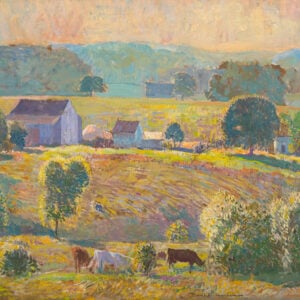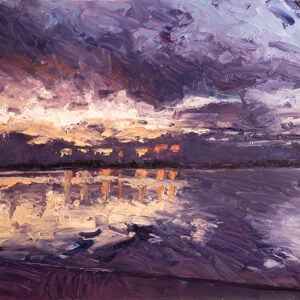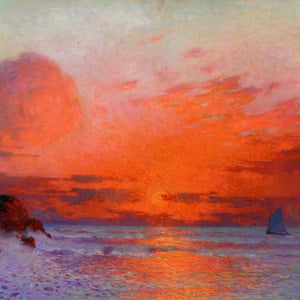In this post, I will be taking a closer look at “The Oxbow” by Thomas Cole. This is a grand landscape painting with undertones about the growth of civilization in America during the 19th century.
Cole was the founder of the Hudson River School, which was a group of landscape painters known for their romantic portrayal of the American landscape. In this post, I’ll cover:
- Key Facts
- Contrast Between the Untamed Wilderness and Civilization
- Intricate Brushwork and Detail
- Using Sketches to Plan the Painting
- Thomas Cole’s Self-Portrait
- Back of the Painting
- Key Takeaways
- Additional Readings
- Want to Learn More?
- Thanks for Reading!

(Before diving into this post, make sure to pick up a copy of my free Landscape Painting Starter Kit.)
Key Facts
Here are some of the key facts about “The Oxbow”:
- It was painted in 1836.
- The title is actually “View from Mount Holyoke, Northampton, Massachusetts, After a Thunderstorm (1836)” but it is more commonly referred to as “The Oxbow”.
- The painting features a stark contrast between the untamed wilderness on the left and the growth of civilization on the right. I go into more detail on this below.
- If you look closely, you will see that Cole painted a tiny self-portrait at the bottom. There is a close-up of the self-portrait toward the end of this post.
- In the distance, you can see logging scars in the landscape as it transitions from the wilderness into civilization. These logging scars appear to read as “Noah” in Hebrew letters (נח). From upside down, it appears to read as “Shaddai”, which is one of the names given to God in the Hebrew Bible. All this was only noticed long after the landscape was actually painted, so it is just speculation as to whether this was done on purpose or not.

Contrast Between the Untamed Wilderness and Civilization
One of the key features of this painting is the contrast between the untamed wilderness on the left and civilization on the right. You can almost cut the painting into two neat sections.
First, let’s take a closer look at the untamed wilderness on the left.
For the sky, dark grays are used to paint the dramatic storm. Notice the subtle variation in color temperature, with some parts picking up the warmth of the light, and other parts being left in the cold shadow.
Cole skillfully hinted at the heavy downpour in the distance, with the brushwork seeming to pull downwards. If you look closely, you can also see lightning in the lower-left of the sky.
The trees, leaves and plants are painted with rich greens and browns; exactly what you would expect to see in the untamed wilderness. There are no strong highlights, with most of the lights being around the middle of the value range. This allows all the colors to appear very rich and full (colors tend to be less saturated at the very light end of the value range).
The trees appear incredibly dense. I am not sure how Cole painted this, but I assume he started with a dark base color then went over the top with lighter greens to add detail. There is also a dull cluster of trees in the distance which helps create a sense of depth in the painting.
Also, notice how organic all the shapes are on the left compared to the more geometric shapes on the right side.

Then we have the right side of the painting which is in stark contrast to the untamed wilderness on the left. My first impression is that of calmness, peacefulness and organization.
The colors are soft and painted within a tight value range. There are no strong darks, with the darkest tone being around the middle of the value range. So on the left, there are no strong lights and on the right, there are no strong darks.
The sky is painted with delicate brushwork and many highlights. The orange streak on the horizon line provides a strong sense of light and really pulls you through the painting.
The river provides that classic “S” shape we so commonly see in landscapes. It also appears very neat. The scattered trees and patches of land show the growing civilization and contrast against the dense vegetation on the left.

Intricate Brushwork and Detail
This is a very busy composition that features intricate brushwork and detail. But there are some areas where there is not much going on, like the blue of the sky and the river. These quiet areas provide some breathing room between the more detailed areas.
Tip: Painting (and life in general) is all about balance. Complex and detailed areas need simple and plain areas, just as much as red needs green, or as light needs shadow.
Cole used a high level of detail all throughout the painting, even for the clouds in the distance. As a result, there does not appear to be a key focal point. Rather, the painting as a whole seems to be in focus. I tend to be more selective with what I paint with intricate detail; this gives me more control over where I want people to look in my painting.
Using Sketches to Plan the Painting
Below is a sketch by Cole which was done in preparation for the painting. Sketches like this are incredibly useful for mapping out and testing your idea before you commit to a large and intricate painting like “The Oxbow”.

Thomas Cole’s Self-Portrait
As mentioned earlier in this post, Cole painted a tiny self-portrait at the bottom of the painting. He depicted himself nestled between the rocks and trees of the wilderness, looking over the river. This adds a personal touch to the painting and also hints at Cole’s close association with the landscape, which makes sense as he built his life around landscape painting. Here is a close-up:

If you look closely, you can even see his signature with what appears to be his other possessions.

Back of the Painting
Here is a photo of the back of the painting. I always find it interesting to see how the master paintings are presented and we usually do not get a chance to see what is behind.

Key Takeaways
Here are some of the key takeaways from “The Oxbow” which you could incorporate into your own paintings:
- Contrast is everything in painting. Cole used contrast to make a point about the growing civilization.
- The subject you are painting should determine the colors, brushwork and level of detail you use.
- If you are going to paint a busy composition, then make sure you plan for it with sketches and other studies.
- Think about different ways you can add a personal touch to your paintings. Cole did this by painting in a tiny self-portrait.
Additional Readings
A Closer Look at “The Starry Night” by Vincent van Gogh
10 Landscape Painting Tips Perfect For Beginners
William Wendt – Inspirational Landscape Paintings
Atmospheric Landscapes By Thomas Hill
Want to Learn More?
You might be interested in my Painting Academy course. I’ll walk you through the time-tested fundamentals of painting. It’s perfect for absolute beginner to intermediate painters.
Thanks for Reading!
I appreciate you taking the time to read this post and I hope you found it helpful. Feel free to share it with friends.
Happy painting!
Dan Scott

Draw Paint Academy







Thank you. Very very interesting!!!!!?
Happy to hear Rache! Thanks, Dan
An insightful description of this painting with lots of good ideas to incorporate into our own artwork. Thank you.
I love the Hudson River Artist school. Nice to see you take the time to analyze The Oxbrow it with such clarity. I love your articles and look forward to them.
Hi Dan
My but you are generous! Thank you for sharing all your knowledge about the various artists and their work.
My pleasure Anne! Thanks, Dan
How did Cole do you think come up with the name “The Oxbow” for his painting? Just curious.
I am a geologist. In geological terms, the sinuous stretch of the river is called an “oxbow”. Simply put.
I’m learning something every time I read your pages and learn more when I read a second time. You bring out so many details that I hadn’t seen and still search for in The Oxbow… such as his signature.
Great to hear Marian! Dan
Thank You so much, I folow all Your steps one by one and realy enyoj i n every worg description ,also in awersome picture
No problem Katja! Dan
A delight to read …thank you! Although I have seen this painting several times in various publications, your commentary really brought a new perspective for this viewer. The term oxbow refers to the curved path cut by the flow of the river which will eventually cut a more direct path and close off the bow or bend in the stream. This most often creates a lake effect where there was formerly a flowing stream.
Thanks Barbara! Dan
Thank you! I live about an hour from this location, and paint upriver often, so it was fun to see a master’s hand. I was especially intrigued with how easily my eyes flowed through the entire composition after noticing the painter first.
No problem Rebecca! That’s wonderful that you live so close to this location. Thanks, Dan
Very interesting read! Clever guy, he was, to hide a tiny portrait of himself like that- I would have never guessed that or even thought to look had you not mentioned it. Thanks for doing the research and sharing!
No problem Shari! Glad you enjoyed it. Dan
Thanks for this article. I am a landscape painting entrepreneur.
My pleasure Miriam. Thanks, Dan
Really interesting post..especially as I had not heard of Cole! I loved the idea of the painting
and think it is really a beautiful landscape painting. Thank you Dan
Shirley
Great to hear Shirley! I agree. Dan
Another insightful and helpful presentation. Thank you. Keep up the good work.
Thanks for your kind words Chris! Dan
The comment by Barbara talks about the oxbow (sinuous curve in the river) being cut off from the main stream. That cut off crescent-shaped lake is called an oxbow lake. I am a geologist, painter. Loved the analysis and the composition.
The comment by Barbara talks about the oxbow (sinuous curve in the river) being cut off from the main stream. That cut off crescent-shaped lake is called an oxbow lake. I am a geologist, painter. Loved the analysis and the composition. This is additional information from my previous comment.
Thanks William! Dan
So much to learn. So much I would never have noticed about this painting without your thoughtful and experienced guidance. Thank you.
Thanks Caroline! Happy to help. Dan
Dan, so glad you shared this from the Hudson River School. I studied Western American History for my graduate degree and of course the art was a fascinating part of our studies. (That was a long time ago as I graduated in the 1980s!) I would love to see the original of this someday. Thank you so much for all the insight you provided regarding Cole’s The Oxbow!!!
No problem at all Joan! I would also love to see an original, in person. Thanks, Dan
Thank you for teaching me how to really look into a painting. It is of utmost value when I learn to paint better.
No problem at all Sandra. Happy to have helped! Thanks, Dan
Oh my gosh! You have opened my eyes at how to look at art. I just dabble. I have a very long way to go. Thank you thank you, thank you.
No problem at all Cathy, happy to have helped! Thanks, Dan
Fascinating! Thank you for this paining and the background on th piece. I thoroughly enjoyed reading through it. I just wrote a paper for school on Cole’s quintet of paintings called The Course of Empire, which really serves as a warning to mankind about the importance of living peacefully with nature rather than conquering and destroying it, lest we eventually destroy ourselves in the process. Because he lived during the Industrial Revolution, with railroads transforming the way civilization interacted with the landscape, and he was a Romantic era painter, he became one of the first conservationists, and that theme is depicted in his paintings. “The Oxbow” seems to illustrate a transition from savage to pastoral in a way that he advocated.
Thanks for your comments and further insight Ingrid! Dan
Thank you for this analysis. One of my instructors doesn’t like this painting because she says it violates the rule of third vertically as well as horizontally, and is not balanced i.e. the same colors appear on the right as on the left. I disagree. The rule of thirds is a kind of cheap rule, in my opinion. And I like how one could diagram the painting one way using value, and another way using color and/or warmth/coolness. I think the tension implied in all those diagrams implies conflict, and I think conflict is a theme of the painting – progress versus tradition, storm versus calm.
Thanks Chris
That is why I think it is good to understand the “rules” but not follow them all that strictly. Art becomes boring if you apply strict rules to it like that.
Thanks! Dan
I need to buy your book how do I go about it.
Hi Deborah
Thanks for your comment.
I will send you the details privately.
Dan
I lost email about, sorry
Just love the ‘5%’ emphasis of red in the umbrella and a smidgen of red on the artist’s jacket, enhanced with another smidgen of white! YUM!! brings the painting alive!
Agreed! Dan
Dan, this was awesome! I’m curious about mixing all the paint to get these greens he used in this painting. Especially the green color on the back and right side of the painting.
Hi Deborah, that green in the back looks pretty warm. So I would assume it has some yellow ochre in there? I am not sure what colors he had on his palette though. Thanks! Dan
Thanks for helping me learn how to examine a painting. I wouldn’t have noticed certain things had you not pointed them out.
It’s my pleasure Sue! Thanks, Dan
Hi Dan,
Great post, I really liked “The Oxbow”‘. I have a particular liking for landscapes although I appreciate brush art in general. The history behind the painting is enlightening, I hope you do more of this in the future.
Thanks, Dave M (Australia )
Thanks Dave! Glad you enjoyed it. Yes more posts like this one to come. Thanks, Dan
And also Dan, regarding the flag/umbrella placed at an angle taking the eye down to the Oxbow, giving a real sense of depth, height and space – this painting is amazing and one would never tire of looking at it!
I completely agree Ruth! Thanks, Dan
For those who don’t quite know what an “oxbow” actually is, the bend in the river gets its name from the “U-shaped” metal piece that forms two double collars, attached to a sturdy wooden bow. The collars are placed around the necks of a pair of oxen to keep them aligned while plowing a field. The wooden cross-piece fits over both animals while the underside of each “U” collar hangs down below and around their necks, kept in place by a bow pin. The plow is then attached to the bow and moves along behind the oxen. Thanks for your insightful analysis of the painting.